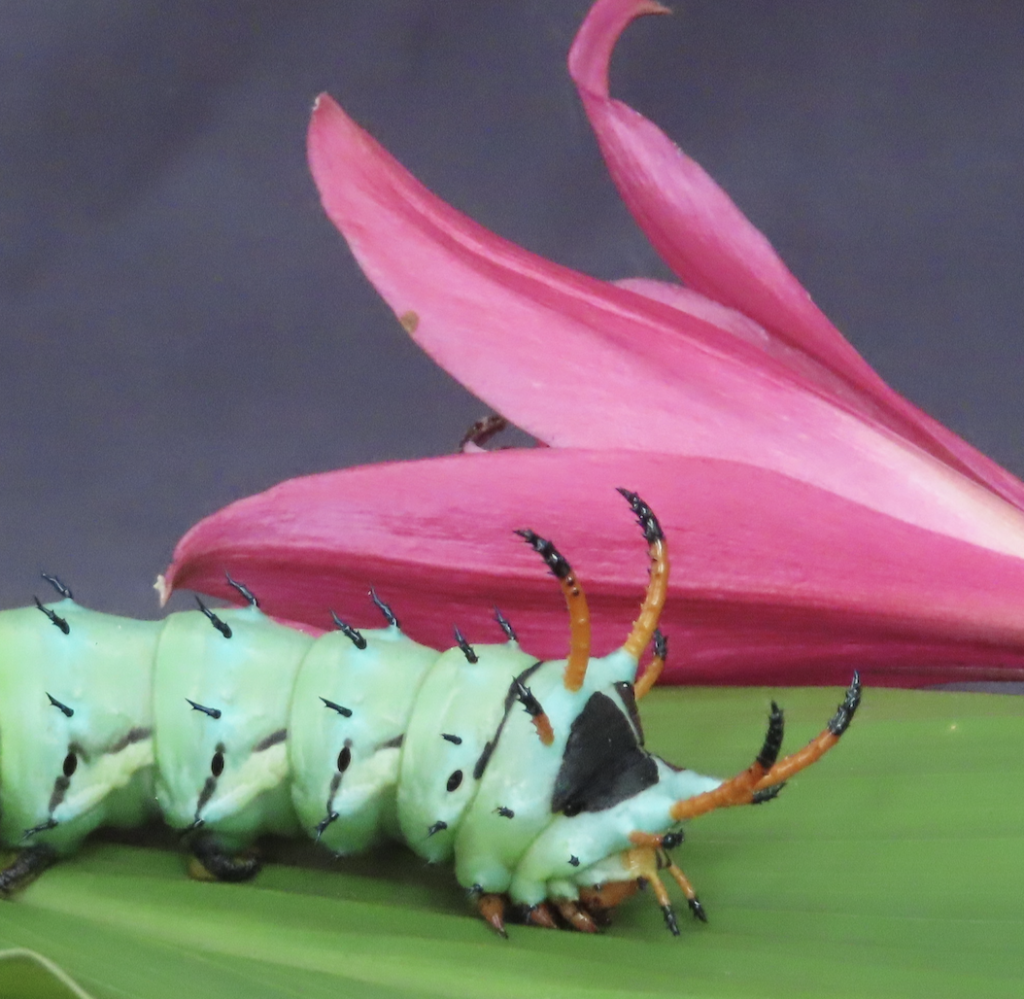
Moths & Me. Lured In By An Ancient Cycle of Milk & Wine Lily Variation
When two individuals of the same plant species cross-pollinate, the seeds and resulting plants vary in size, flower color, petal shape, and even vigor. That variation among individuals, good for people and animals too, ensures adaptability and continuity of the species. Variations bring flexibility and strengths. Over hundreds of millions of years, some plants adapted and animals adapt together to ensure resilience through variation.
Some people, like me, manipulate this cycle. We mix and match pollen from one flower to another hoping to find a variant that’s pretty, fragrant, compact, or has other characteristics that gardeners might love. Then we observe, sort through thousands of seedlings, and move on to an entirely different process: trying to figure out how to clone that one single plant in order to maintain the traits we like.
This is the story of how one particular plant and one type of moth evolved together so that they both get some benefit from this process. There’s a parallel story of how I, searching for pretty flowers, jumped into the long-established process and came out with a new special flower and deep respect for the beauty and complexity of mutual adaptations in nature.
Way back in 2001, in the spring before terrorists took out the World Trade Center, I’d spend days gardening for a living and evenings one of two ways. Either in a brewery with a cast of characters including a neurotic trust fund fella, a cheerful but brusque barmaid, and an odd guy who invented a guitar-like instrument he’d play occasionally– the electric rake.
But many nights, I’d go out alone, into my own little messy field where I’d been growing one particular flower from seed for years.
In the twilight, something lured me one way or another. A tiny neon light, a certain pick-up truck parked in front, a snippet of a Tom Waits song, and the barely perceptible smells of fried mushrooms on the breeze. In an unexplained combination, those things set off internal triggers, built anticipation, promised rewards, and lured me toward the brewery.
Other nights, other imperceptible lures drew me to the field where seedlings of my obsession, Crinum bulbispermum, flowered in the weeds. Since I’d grown all these from seeds collected in the 1990s, I had an array of different-sized flowers and plants. That’s what happens of course- with sex and offspring. Look at any group of 100 children, puppies, or plant babies and you’ll see that most look pretty much the same. One or two stand out. They vary significantly. That was true for my thousands of Crinum bulbispermum plants.
How I manipulate the process for variation of flowers and plant habits comes later in this story. The system I’m working with is complex, ancient, and beyond my real comprehension. But the system plays into how I do what I do, so first, I’d like to attempt to share this compelling interaction, this million-year mutualism between crinum and moth as best I can.
…
Out in the wilds of Southern Africa, this plant has developed some traits that help it ensure great variations through the mixing of genes between one plant that may be miles away from another. Thorough mixing of genes ensures variation, therefore survival of the species. But that thorough mixing of genes can be tough for a plant whose volleyball-sized bulb grows deeply in the mud. How is one plant to get its pollen way across the marsh to another?
Over two hundred million years or so, Crinum bulbispermum flowers developed a relationship with the perfect pollinator. Stronger than a bee, more reliable than a breeze, with more endurance than a fragile butterfly, crinum flowers do things, right at dusk, to awaken and attract moths. Somewhere over in a thicket, as the sun sets, big, strong, far flying moths wake up. Moths possess an amazing ability to detect ‘smells’ in the air. From miles away, they detect chemical fragrances the crinum flower starts to pump out, just as the sun sets, just as the moth’s wake.
It all starts when a thick flower stalk pushes up a dozen cigar-shaped flower buds all held closed but together in a bouquet. The buds don’t release fragrances but on a perfect evening, one bud slowly lifts itself from a hanging position. It moves upward, and petals unfurl. The flower literally rises and its petals pop open in a release of tension. Anthers, the pollen-bearing parts of the flowers, the male parts, push forward, laden with powdery pollen grains. You can watch all this happen if you just sit still. It takes a while, but it’s worth the wait, as magical as a slow-motion film.
What you cannot see is a chemical system within the tissue of the plants. A chemical system starts to pump. Fragrances so complex scientists have only recently analyzed them, pour into the air as the flower opens. This you can’t see but you can sure smell the air change. Where before there were the smells of earth and grass, there’s now a sweet, sharp, fragrance with a bit of pine needle mixed in. It’s mostly gaseous, but down deep in the floral tube, liquid nectar that tastes like the flower smells fills the floral tube.

To avoid self-pollination, the male and female parts within the same flower are ready at different times.
Standing in a group of crinum, the light diminishes, flowers expand and this cloud of what I might call perfume surrounds me.
Miles away, moths get it too. Unlike me, moths sense just a note, a whiff on the breeze. They detect a molecule of lure, a promise of a drink, they may even detect minerals, chemicals, and nutrients they specifically need. This chemical fragrance factory inside the flower is more than a pleasant smell. It’s the promise of something a moth needs. So they fly through darkening air, following fragrance. It’s practically dark by the time they get to the flowers. Scientists know moths perceive colors really well, even in the dark. So they could stop to seek a drink at any flower along the way– a pink amaryllis or an orange lily. But one flower shines in the dark. White or yellow, pale Crinum flowers beam, reflecting moonlight, guiding the moths. You can test this theory sometimes. Wear a white shirt on an evening walk while a friend wears a red shirt. You’ll get all the attention from moths.
From its fragrant flight, moths dive in right into that pale crinum flower. Recent research demonstrates that certain moth’s proboscis are almost exactly matched to the length of a crinum floral tube. Unfurling that tongue, that proboscis, reaching way down in for a lovely drink of nectar, the moth gets covered with pollen grains. Body, antenna, face, and all. Each pollen grain contains sperm cells which, for reasons we’ve discussed above, the plant needs to be distributed to some receptive female flower parts somewhere far away.
Moths are messy. Unlike birds and even roaches, moths don’t groom. Covered with pollen they go on all night, drinking and carrying on and making sure that their next generation of moths has a next generation of Crinum to feed on.
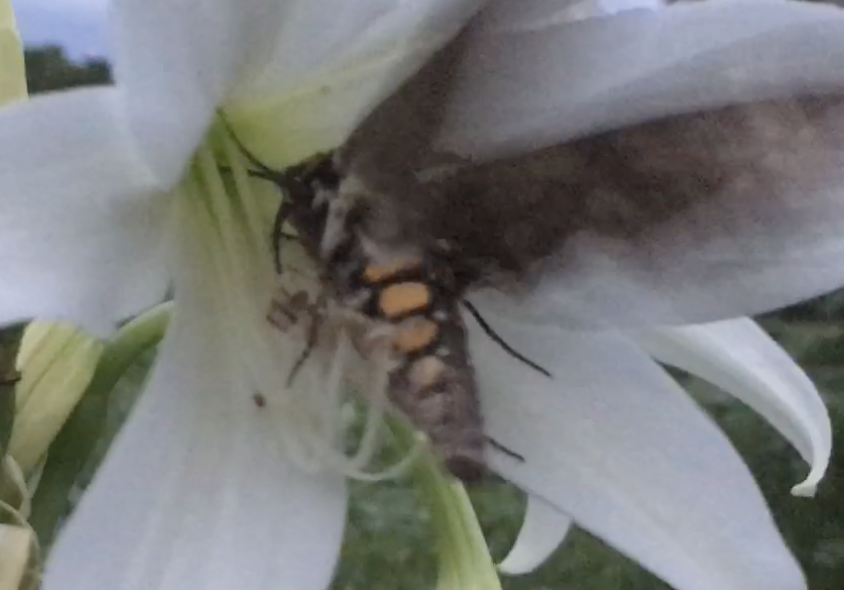
Diving in to get at the sweet and fragrant nectar, this hawk moth also gets covered with pollen grains that may fertilize the female parts of the next flower.
As the sun rises, that crinum flower cuts the fragrance production, the flowers close up a little and they start to hang down. No need to spend energy looking great during the heat of the day.
If the female stigma received fresh pollen, the now fertilized ovaries start to expand. Seeds form over weeks. A month later, seeds fall to the ground or maybe into a stream, and germinate. It takes three or four years for Crinum bulbispermum to grow strong enough to make flowers. Along the Orange River (for which this plant gets its common name, the Orange River Lily) and throughout other wild parts of South Africa, the cycle starts again.
…
Oddly enough on the other side of the globe, in my South Carolina field, the same thing happens. In my field of African lilies, at sunset, the same fragrance wafts into the air. Somewhere way down the woods, sleeping in the branches of a sweetgum tree, an American moth, a cousin to that African moth, detects a molecule in the air, flies over, and does exactly the same thing. She’s lucky. These Crinum are lucky. I’m lucky. Not everywhere in the world has a moth with all the right parts and all the right smell receptors, all the right skills, to carry on this cycle.
I love to watch it. But sometimes I intervene. For different reasons, but like those moths, I’m lured into the field in the evening and I too carry pollen from one flower to another. Sometimes, I have a goal such as putting pollen from a pink-flowered male onto a dwarf white plant with hopes of one day getting a dwarf pink-flowered crinum. But mostly, I just do what the moths do. I wander around in the twilight with a drink, getting some pollen on my fingers and rubbing it on some other flower. A month later I collect seeds and sow them. Over the years I’ve collected and grown out thousands on thousand of Crinum bulbispermum.
Each one is different. Flower size, color, and even petal shape differ. Plant vigor does too. Some grow fast and tall and make big plants and some stay small. Subtle things vary too. Some flowers fade through different colors as they age. Some stand up strong while others flop over into the dirt. Some make tons of big, heavy seeds, and some tiny pebbles.
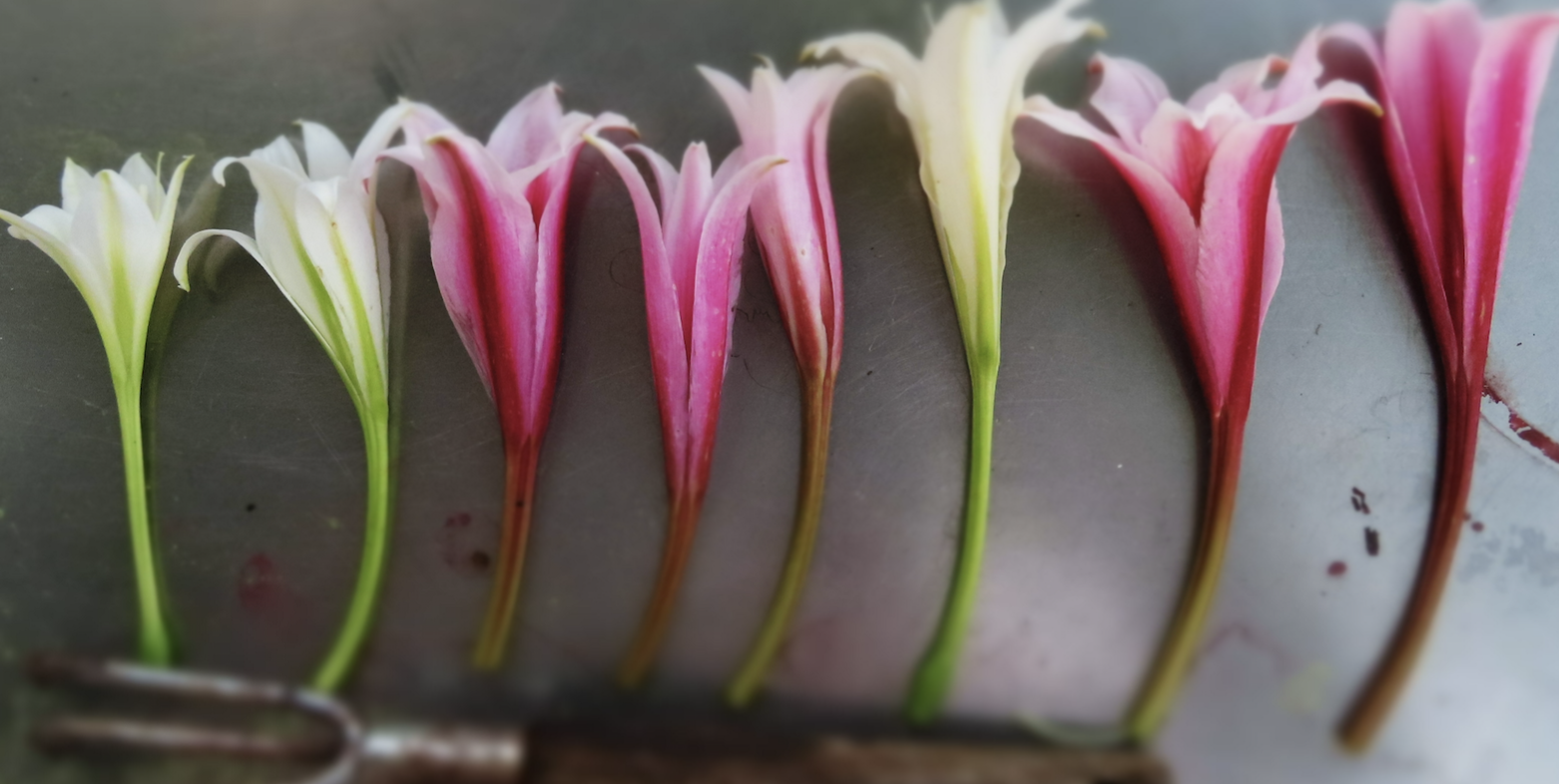
Sexual reproduction often leads to variation. This crinum ranges in size and color but all came from the same seed collection.
From a gardener’s point of view, lots of those differences don’t really matter.
But one plant, just one among all those I’ve grown, stood out.
I love plants that change colors. The mutations fascinate me. This one shows off an art-deco array of pastel flowers, opening creamy green, on that first night. The next day, tan, green, white flush through the petals. But on the second night, that flower having done its work fades to a soft pink. Later it deepens to rich pink all the while new flowers open creamy green. The multi-color flowers on one plant look like a bouquet from Eden or from the heavens.
I moved this plant around in the fields and later into the gardens. You see, sometimes flower color variations in crinum can be caused by the chemistry of the soil. So I wanted to be sure this multi-color effect worked for other people, not just in one spot. I watched other garden traits too. I watched to make sure the flowers stood up tall as floppy crinum flowers do not impress me.
I shared a few small plants with some botanical gardens to get their opinion. Then, only then, did I decide this plant should have its own name and be reproduced vegetatively so that every plant I share would be as extraordinary as the first. This process of vegetative reproduction proved very slow.
After ten or twelve years of evaluation, I took a bouquet of flowers to show off to my friends at the local brewery. We sat outside, watching the sunset. Whiffs from the kitchen mixed with the fragrance of the flowers – even cut and in a bouquet, crinum flowers follow the same cycle. I showed off the green, rose and pink flowers one creative guy said, “You should name it Aurora Borealis.” I loved that. But my friend Hunter made the perfect adaptation, honor your Mother he said, “call it. Crinum bulbsipermum ‘Aurora Glorialis’.”
Almost 20 years after that fateful night, the night that the scents of flowers attracted me we have enough ‘Aurora Glorialis’ to share. Knowing what I know now, I can’t really take credit for it. It’s much more likely that a moth, driven by instincts and biology, made this plant. Its offspring, generations down the line, come to our row of ‘Aurora Glorialis’ in the nursery when they burst into a fragrant, kaleidoscope of color in May.
In the early years, I only cared about flower color and garden characteristics. Now with respect and fascination for a cycle that I can only partially comprehend, I’m devoted to adding more plants that attract moths. I determined to protect the wild parts of the field, where ‘weeds’ and sweetgum trees thrive. No complaints about sweetgum balls, the moth’s larvae need those leaves to eat and those plants are part of systems that are older and more important than I am. They are part of what we need to leave for our next generation, so they’ll fall in love, protect and hopefully understand they are part of a natural system that protects us.

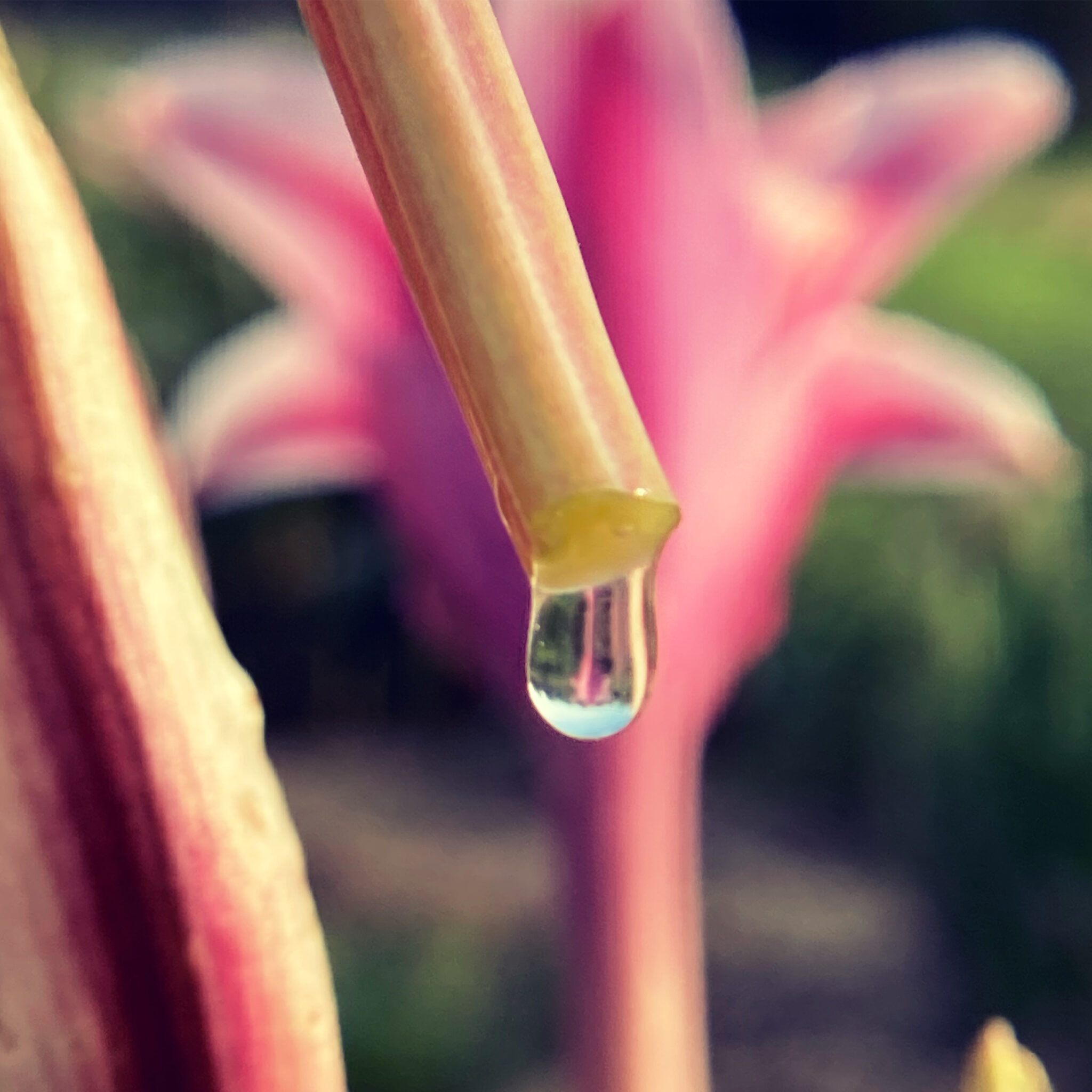
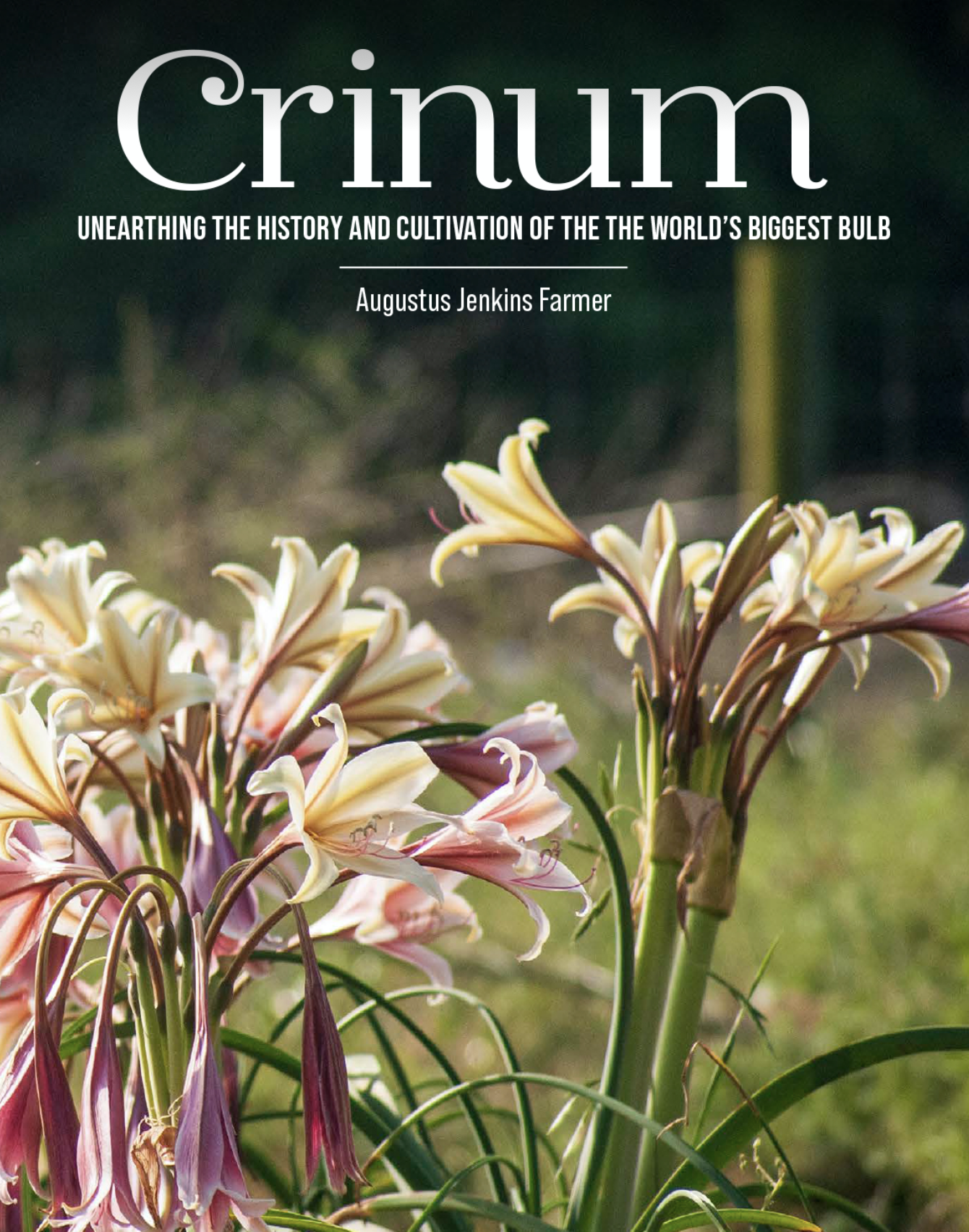
A friend gave me several large crinum bulbs that she said were very old. They are called Milk and Wine. Is this what you are talking about.
Milk and wine is a common name that gets applied to many different types. Most often, I hear it applied to an offspring of the plant I’m talking about — one that has a very strong, deep red center to the white flower. The one I’m writing about sets seeds readily, while many of its offspring never set seeds. Does that help?
what fascinating story telling. Cannot wait until dusk and get out there quietly and see what is really going on in the garden.
Teresa
I love to be out there. But these days, I’m kinda worn out by 7 and just head inside. It’s hard working hard!
I enjoyed your story. It’s truly fascinating how nature works, especially at night.
Oh Jenks a delightful read. No crinums here in the PACNW but I can imagine … Thanks
How do you get the flower stalks to stand upright as mentioned in the article. Some of mine droop to the ground even b4 the buds open.
Tried to transplant a pup and it died. Any tips?
Thank you!
All depends on which species or cultivar? I grow cultivars that stand up best. Some simply don’t and never will — there’s a common pass-along that I see at plant swaps and stuff that I simply call floppy white — cause that’s what it does. So the answer is only plant good strong, tested cultivars and know your source. Having said all that, there are two times almost anyone will fall. First, in serious drought as the cell walls cannot get turgid. and Second, at the end of flowering cycle, many of them fall because that is part to the way they distrube seeds.
What a wonderful story. I so enjoyed that.
I am now in love with this plant I have never seen. Sensuous, beautiful writing.
Why thank you Annie!
I’ve heard & seen your name come up in many a Charleston gardening conversation, with the utmost authoritative respect for your horticulture knowledge; yet, comically in hindsight, have never heard any reference to your web site, books or sales. Or, maybe (typically) I just didn’t pay attention to detail!
People remark: “Jenks Farmer says…”, “Jenks Farmer has…”, or “I asked Jenks Farmer…”.
Well, a huge shout out to Chris Deer, who passed along your web site address; because, (wow!) consider me star struck!!! Unaware of what I was missing out on, I will get up to speed; so, I can join the ranks of “Jenks Farmer says/suggests/has …”.
Your newest fan, Holly
Well, thanks to that good guy Deer — and glad to know you too. Looking forward to a work trip to Chas in June so if you want anything big, let me know!
Aurora Glorialis – such a poetic name for the crinum! I so enjoyed this piece.
Such lovely writing.